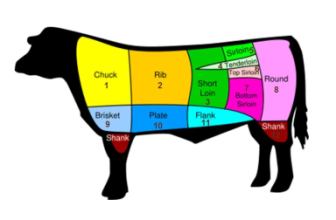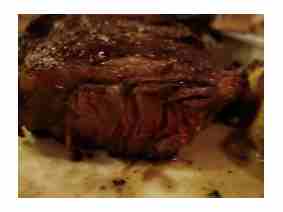
Beef Recipes for the Grill,
the BBQ and the Kitchen

Beef is a very versatile meat, and beef recipes cooked and prepared properly, whether on the grill, in the BBQ or in the kitchen can be hearty, rich and a treat to the taste buds.
In case you are interested, most cattle (also known as bovines) originate from "Old World Europe," except for certain lines of cattle which came from North American bison.
But...you obviously didn't come here for a history lesson. Let's talk about the various cuts, popular cooking methods for each and then the REAL reason you came here....GREAT beef recipes! And don't worry. As I try new recipes I will be certain to add them to this section of BBQMyWay.com.
Grades of Beef
The USDA grades all beef products, and it will help your shopping efforts to have a general understanding of these terms when deciding which grade will work for your beef recipes.
A word of warning. When you see an advertisement that says "USDA Grade Beef" as if it's a statement of quality is totally misleading. All beef by law is graded by the USDA!
Generally, the more fat that is marbled into the muscle itself (as called intramuscular fat), the higher the USDA grade. An extremely thorough examination of the carcass is conducted and the rib eye steak is used as the standard cut of grading purposes.
Why is marbling important? More marbling results in richer taste and a more tender cut of meat. So without further a due, below are the grades.
- Prime: This is the Rolls Royce of beef. Only 3% of all beef is considered choice, and most of it ends up being sold through high-end restaurants.
- Choice: Typically this is highest quality you can purchase at a supermarket or from your butcher. Sufficient marbling to result in a great cut
- Select: This is the leanest grade sold commercially. Because of that, the cuts will lack flavor and tenderness compared to "Prime" and "Choice".
The remaining grades listed are for informational purposes only. The cuts from these grades usually end up ground, in hot dogs or in dog food. These grades in descending order of quality are
"Standard," "Commercial," "Utility," "Cutter" and
"Canner."
Subscribe to "The BBQ Gazette"
I do a little newsletter called "The BBQ Gazette." In this monthly newsletter I share new BBQ and grilling techniques, recipes, my opinions on various brands of grills, utensils, rubs and sauces.
I also discuss how to compliment your dish with the perfect beer or wine.
Just fill in the blanks below, and please don't worry. Your email address is totally safe with me.
Cuts of Beef

There is an old saying in the meat industry. "The further away from the horns and hooves, the more tender the meat." This is because the legs and the neck of the cow get the most work, making the cuts from these sections leaner and tougher. Please refer to the diagram at the top of this page. This information is invaluable when picking your beef recipes.
- Chuck: Typically ground and used for hamburger
- Rib: Short ribs and rib eyes
- Sirloin: Steaks from this cut have lots of flavor but not as much marbling
- Short Loin: This is where the porterhouse steak comes from, which includes a section of the tenderloin
- Tenderloin: Filet Mignon. Need I say more?
- Brisket: Lots of flavor but very lean. Typically slow cooked. A main stay on the BBQ circuit.
- Plate: Produces the toughest and cheapest steaks
- Flank: The flank steak is long and narrow with lots of "grain" to it. Very lean. Most cooks marinade this cut to promote tenderness. Also prepared as a "london broil"
- Shank: Never used in beef recipes other than soups and stews
Beef Cooking Temperatures
Regardless which of the beef recipes you use, you should generally know what temperature results in what level of "doneness."
Below is a chart that roughly details the temperatures for beef. Always remember that different meats (fish, poultry, pork or beef) have their own set of internal temperature guides to refer to. This one is for beef.
Beef is cooked (roughly) on the following scale, based on the internal temperature of the meat.
| Cooked | Traditional Temp. (USA) | Description |
|---|
| Very rare | 115 – 125°F (46 – 52°C) | Blood-red meat, soft, very juicy |
|---|
| Rare | 125 – 130°F (52 – 54°C) | Red center, gray surface, soft, juicy |
|---|
| Medium rare | 130 – 140°F (54 – 60°C) | Pink center, gray-brown surface, often remains juicy |
|---|
| Medium | 140 – 150°F (60 – 66°C) | Slightly pink center, becomes gray-brown towards surface |
|---|
| Medium well | 150 – 160°F (66 – 71°C) | Mostly gray center, firm texture. |
|---|
| Well done | >160°F (>71°C) | Gray-brown throughout, tough texture. |
|---|
Grilling Filet Mignon
Pork in a Beef Patty
Steak Fajita Recipe
Grilling Steak Recipe That's Different
Hickory Smoked Bone-In Rib-Eyes
Hearty Beef Stew Recipe
Italian Beef Sandwich Recipe
Jacked Up Meatloaf
Award Winning Chili Recipe
Sloppy Joe (Poe) Recipe. Howard Cosell Called Me!
Silky Prime Rib on the Weber
Blackened Prime Rib
Barbecue Meatball Recipe
Secrets to Grilling Hamburgers
Leave Beef Recipes and Return to BBQ My Way Homepage.
Does this page make you hungry? Please pay it forward!
Would you prefer to share this page with others by linking to it?
- Click on the HTML link code below.
- Copy and paste it, adding a note of your own, into your blog, a Web page, forums, a blog comment,
your Facebook account, or anywhere that someone would find this page valuable.










